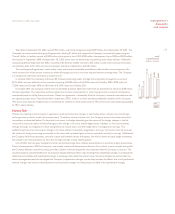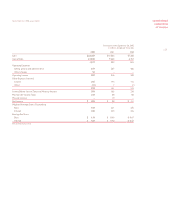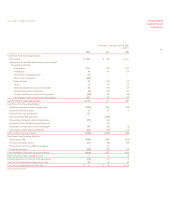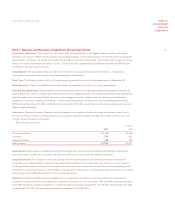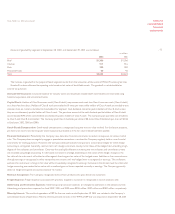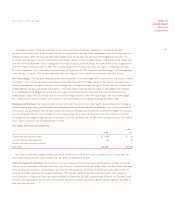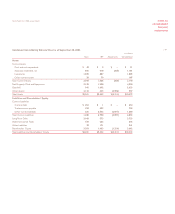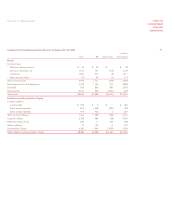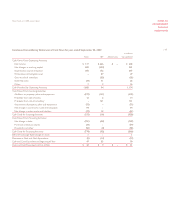Tyson Foods 2002 Annual Report Download - page 35
Download and view the complete annual report
Please find page 35 of the 2002 Tyson Foods annual report below. You can navigate through the pages in the report by either clicking on the pages listed below, or by using the keyword search tool below to find specific information within the annual report.
notes to
consolidated
financial
statements
p 33
Use of Estimates: The consolidated financial statements are prepared in conformity with accounting principles generally accepted
in the United States which require management to make estimates and assumptions that affect the amounts reported in the
consolidated financial statements and accompanying notes. Actual results could differ from those estimates.
Recently Issued Accounting Standards: In June 2001, the Financial Accounting Standards Board (FASB) issued Statement
of Financial Accounting Standards No. 142, “Goodwill and Other Intangible Assets” (SFAS 142). Under SFAS 142, goodwill and
indefinite lived intangible assets are no longer amortized but are reviewed annually or more frequently if impairment indicators
arise, for impairment. Separable intangible assets that have finite lives will continue to be amortized over their useful lives.
The Company elected to early adopt the provisions of SFAS 142 and discontinued the amortization of its goodwill balances and
intangible assets with indefinite useful lives effective September 30, 2001. The Company assessed its goodwill for impairment
upon adoption, and completed its required annual test for impairment in the fourth quarter of fiscal 2002. Neither impairment
test indicated any impairment losses. Had the provisions of SFAS 142 been in effect during fiscal years 2001 and 2000, a reduction
in amortization expense and an increase to net income of $30 million or $0.14 per diluted share and $29 million or $0.13 per diluted
share respectively, would have been recorded.
In accordance with the guidance provided in Emerging Issues Task Force (EITF) Issue No. 00-14, “Accounting for Certain Sales
Incentives,” and EITF Issue No. 00-25, “Vendor Income Statement Characterization of Consideration Paid to a Reseller of the
Vendor’s Products,” beginning in the first quarter of fiscal 2002, the Company classifies the costs associated with sales incentives
provided to retailers and payments such as slotting fees and cooperative advertising to vendors as a reduction in sales. These costs
were previously included in selling, general and administrative expense. These reclassifications resulted in a reduction to sales and
selling, general and administrative expense of approximately $188 million and $142 million for fiscal years 2001 and 2000, respectively,
and had no impact on reported income before income taxes and minority interest, net income or earnings per share amounts.
In August 2001, the FASB issued SFAS No.143, “Accounting for Asset Retirement Obligations.” This statement requires the
Company to recognize the fair value of a liability associated with the cost the Company would be obligated to incur in order to
retire an asset at some point in the future. The liability would be recognized in the period in which it is incurred and can be
reasonably estimated. The standard is effective for fiscal years beginning after June 15, 2002. The Company expects to adopt this
standard at the beginning of its fiscal 2003. The Company believes the adoption of SFAS No. 143 will not have a material impact
on its financial position or results of operations.
In October 2001, the FASB issued SFAS No. 144, “Accounting for the Impairment or Disposal of Long-Lived Assets.” SFAS No. 144
develops an accounting model, based upon the framework established in SFAS No.121, for long-lived assets to be disposed by sales.
The accounting model applies to all long-lived assets, including discontinued operations, and it replaces the provisions of ABP Opinion
No. 30, “Reporting Results of Operations –Reporting the Effects of Disposal of a Segment of a Business and Extraordinary, Unusual
and Infrequently Occurring Events and Transactions,” for disposal of segments of a business. SFAS No. 144 requires long-lived assets
held for disposal to be measured at the lower of carrying amount or fair values less costs to sell, whether reported in continuing
operations or in discontinued operations. The statement is effective for fiscal years beginning after December 15, 2001. The
Company intends to adopt this standard at the beginning of its fiscal 2003. The Company believes the adoption of SFAS No.144
will not have a material impact on its financial position or results of operations.
In July 2002, the FASB issued SFAS No. 146, “Accounting for Costs Associated with Exit or Disposal Activities.” SFAS No.146
addresses financial accounting and reporting for costs associated with exit or disposal activities and replaces EITF Issue No. 94-3,
“Liability Recognition for Certain Employee Termination Benefits and Other Costs to Exit an Activity (including Certain Costs Incurred
in a Restructuring).” SFAS No.146 requires that a liability for a cost associated with an exit or disposal activity be recognized when
the liability is incurred. SFAS No.146 also establishes that fair value is the objective for initial measurement of the liability. The statement
is effective for exit or disposal activities initiated after December 31, 2002. The Company believes the adoption of SFAS No.146 will
not have a material impact on its financial position or results of operations.
Tyson Foods, Inc. 2002 annual report


